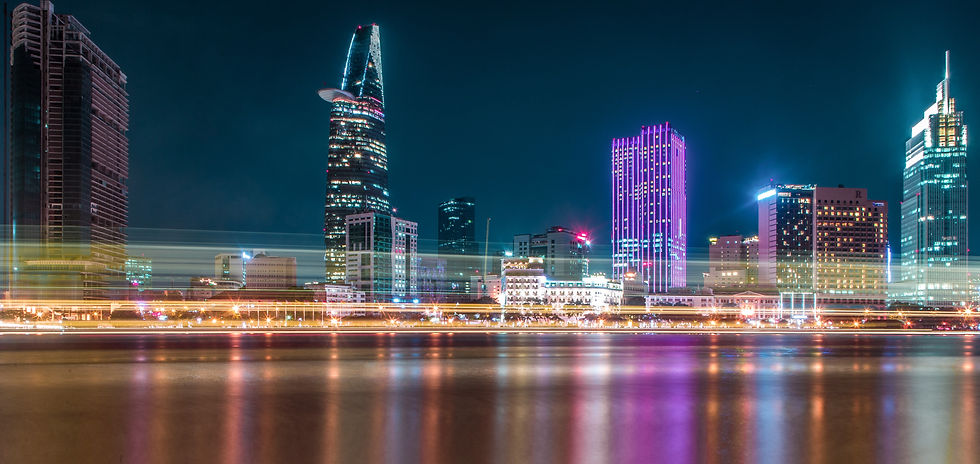Things you need to know during your stopover at Ho Chi Minh
- Rainbow Travel inc

- Nov 10, 2020
- 4 min read
Updated: Nov 20, 2020
November 10 2020

Where to eat
Several restaurants are rethinking Vietnamese cooking by giving it a modern twist. Bà Bà in D1 is one such place. Run by a French-Vietnamese couple and serving inexpensive bowls of rice noodles and spring rolls, it’s a modern iteration of a mom-and-pop shop, and a sleeker alternative to the omnipresent street stalls.
Quan Bui, with branches in both D1 and D2, does local classics in a polished ambience, while Anan, one of the hottest tables in town, presents experimental new Vietnamese cuisine just upstairs from Chợ Cũ, Saigon’s oldest street market. Helmed by chef Peter Cuong Franklin, the restaurant features innovative dishes like banh xeo tacos and street-style Dalat pizza, and it’s a must to get a taste of the country’s evolving gastronomic scene.
For a healthy poolside lunch, try newly opened L’Herbanyste in a refurbished villa in D2, for fresh salads and tofu scrambles. Upstairs, a small spa by the same folks offers all-organic facials and massages. Prem Bistro, a boho-chic three-story space in D3 that features a leafy patio, rooftop, and plenty of cushion pillows for floor seating, also caters wellness-minded types: items like shirataki noodles and Moroccan zaalouk are available alongside weekly yoga and meditation classes. If a more indulgent meal is what you’re after, Tomatito, a boisterous Spanish spot, is the place for a night of tapas and sangria.
Chinese-Vietnamese food is best in Cholon—and especially atHai Ki Mi Gia, a legendary family-run institution specializing in mi vit tiem, duck leg and yellow egg noodles served with mustard greens in a rich, dark broth seasoned with medicinal herbs and spices.

The Banana Mama rooftop bar in District 1 Courtesy Banana Mama
Where to drink
Saigon loves its coffee (Vietnam is the largest exporter of robusta in the world). The Workshop, on the top floor of a crumbling building in D1, is particularly serious about it, serving specialty beans to third wave coffee devotees. For great blends with a side of interior design drool, go to T House Cafe in D3. Hidden down a tiny lane, it was designed by local architecture firm Kientruc O, and it’s a mix of tropical garden and bright communal spaces, with big textured glass windows and all-white walls. September Saigon, in D5, is designed with the Instagram set in mind, with excellent lattes to boot. If you’re in Thao Dien, stop at shack-like Dolphy Café for ca phe sua da—classic iced coffee with condensed milk. It’s thick, sweet, and very strong. Come evening, the drinking scene is just as expansive. Notable craft breweries have popped up in recent years between D1 and D3, from Pasteur Street Brewing Company, which was one of the first to open and counts three taprooms, to the smaller Heart of Darkness Brewery and the huge BiaCraft Artisan Ales. All serve beers that often incorporate local flavors, from jasmine to papaya, jackfruit and even durian.
Generally found inside aging commercial buildings, many of Saigon’s cocktail bars wouldn’t look out of place in New York City. Take D1’s Drinking & Healing, a handsome space of raw brickwork, concrete beams, and a lofty vaulted ceiling, where patrons can request bespoke creations from a crew of dapper mixologists. Apt852, in D3, is another gem: a Hong Kong–style bar with red neon lights, blue velvet high chairs, and mah-jong sets used as tables, where stiff drinks come in Chinese teapots and medicinal bottles, and old Chinese ballads play in the background. For alfresco drinking, try the tropical Banana Mama in D1, which has a view of Saigon’s rising skyline and it’s delightfully hipster; or the chicer Social Club Rooftop Bar, in the Hotel des Arts in D3. It boasts even better panoramic views of the city. Want to dance? Newcomer Bam Bam, a Bali-inspired venue featuring a beachy décor and lush greenery, is your place. The dance floor is an empty swimming pool, so you get the idea.
Where to tap into local culture

HCMC’s art movement might still be small, but it’s blossoming. Housed on the second floor of an old tenement apartment in D1, 289e is a good place to start exploring it. A multidisciplinary venue doubling up as cocktail lounge, it runs weekly film screenings, gigs, and rotating exhibitions. The Factory Contemporary Arts Centre and Vin Gallery, both in D2, are two other noteworthy independent spaces, both keeping the emphasis on local talent. Closer to the riverside, be sure to stop by Saigon Outcast, a spacious multipurpose complex hosting festivals, weekend fairs, outdoor cinema and concerts. Down an alley in D3, Salon Saigon puts up art shows and cultural events in a restored French colonial mansion that used to be the residence of U.S. Ambassador Henry Cabot Lodge from 1963 to 1967.
Where to stay

D1 is the obvious lodging choice for most travelers—and where the swankier hotels are, from the Reverie Saigon to the Park Hyatt Saigon. But a cluster of boutique hotels across the city offers a more character-filled—and equally cushy—stay.
The 108 rooms at Myst Dong Khoi blend a minimal aesthetic with traditional local touches, like hand-carved rosewood benches and recycled timber sofas based on the Vietnamese platform beds of yesteryear. Outside, an eclectic all-white exterior is dotted with wild, tropical plants growing from the balconies, while the lobby sits under a ceiling made of roof tiles, iron beams and metal grills reclaimed from old Saigon shipyards.










Comments